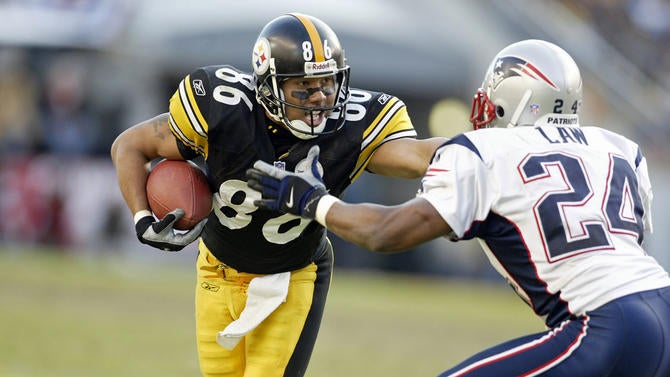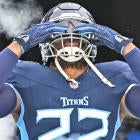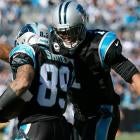LATROBE, Pa. -- Used to be, the hallways and dorms at tiny St. Vincent College, here in the hills of Western Pennsylvania, were haunted by the ghosts of linebackers of yore. Ham. Lambert. Greene. Lloyd. Kirkland. Porter. They came to training camp angry and menacing, frothing for their first big hit of the summer.
Think Steelers football and the first imagine conjured was of a bloodied, occasionally toothless, linebacker brutalizing a ball carrier or crushing a quarterback. The blue-collar people of Pittsburgh, at a time when coal still fueled the local economy, loved their football black and (yellow and) blue. They rode a physical run game and the occasional big play to an explosive wideout on offense (Stallworth and Swann), but their dynastic lifeblood ran through the heart of that defense.
Not so much anymore.
The Steelers still produce some quality linebackers -- Ryan Shazier is the best and brightest of the current crop, and an ageless James Harrison is still the most intimidating -- and remain an annual Super Bowl threat. But the days of a constant pipeline of Hall of Fame linebackers or All-Pros are over. And they've been replaced by a position group on the opposite end of the spectrum, one stereotyped in general by flamboyant divas, me-first guys who talk big and are known to sport $100,000 diamond earrings.
If the Steelers are to get back to the top of the AFC, if they are to find a way to get by the New England Patriots in the postseason and hoist their seventh Lombardi Trophy, it stands to reason their wide receivers will have much to do with it. Once again, they are blessed with one of the very best at that position, Antonio Brown, and a deep reserve of young and hungry receivers on the cusp of fame and glory themselves. For whatever reason, since selecting Hines Ward in the third round in 1998, the Steelers have built an unmatched lineage and legacy of pass-catching greatness, doing it for the most part without spending top-50 draft picks.
No organization has continually had a keener eye for evaluating receivers, or a more deft touch developing them than the Steelers, culling max value from mid-to-late round selections and only the occasional high pick (Plaxico Burress, eighth overall in 2000). Since then, they've seen Super Bowl XLIII MVP Santonio Holmes (25th overall, 2006), Mike Wallace (84th overall, 2009), Emmanuel Sanders (82nd overall, 2010) and Brown (195th overall, 2010) all produce 1,000-yard seasons. All but Holmes reached the Pro Bowl and Brown blossomed into arguably the best in the entire NFL. And hopes are very high that Martavis Bryant (118th overall, 2014) will be the next in line after he sat out all of 2016 due to a suspension. He has been reinstated to participate in meetings here at camp but the league office won't allow him to practice yet, a truly puzzling scenario.

Now, nearly 20 years into this run, surely there is more to it than simply good fortune. I imagined a secret formula of sorts, locked away in a vault, carried over from Three Rivers Stadium to Heinz Field, with the Ward-to-Brown chain extending through multiple general managers and coaches and quarterbacks and offensive schemes. While chief rivals like the Ravens and Browns have barely been able to draft a single receiver to make even a short-term impact, Pittsburgh has always had a bona fide No. 1 in place and usually a contender or two to replace him in short order.
"I really don't think there is any secret sauce," general manager Kevin Colbert, who has been with the Steelers since 2000 and their GM since 2010, told me. "We evaluate receivers just like we evaluate any other position. We've had more good fortune than bad fortune with that position, but there's no difference in anything we do. It's no different."
Yet the success has been astonishing.
Not that Colbert and the Steelers' football operations department don't have a pristine reputation across the board, but the ability to find receivers has been uncanny. They are of different body types and have different attributes -- short, tall; slot guys and outside guys; those who can return kicks and those who can't. And, to be fair, the Steelers haven't been perfect in picking them. But then even some who get injured and don't pan out, like Markus Wheaton (79th overall in 2013) quickly find work when they hit the market. He got a two-year deal with the Bears this spring.
Ward's selection predates Colbert's time here, but it's easy to see why an uber-physical receiver and dominant blocker in the run game would have appealed to former coach Bill Cowher. Time will tell if Ward gets to Canton. Burress' selection came in that rarest of years where the Steelers had a top-10 pick, but the hot streak hardly stopped there.
"You go back to Plax and that was an easy pick, that wasn't hard," Colbert said. "And the draft with Emmanuel [Sanders] and Antonio, we had them rated very closely. Emmanuel was a little more predictable because he was a senior and we'd seen him in the East-West Shrine Game.
"So when we took him in the third round it wasn't like we had Antonio stashed or anything like that. We had Antonio rated in the same range. But when we took Emmanuel we backed off the receivers, then when we got to the sixth round, Antonio was really too good to pass up.
"When you think back individually, Plax's size and athleticism stood out. Emmanuel's overall play and ability to return. Santonio's play and ability to return. Mike Wallace's speed was unique. It's just that Mike and Antonio and Emmanuel all kind of happened together. … It's not that receivers are easier to evaluate, but you see them do certain things [in college] that are very similar to what they're being asked to do here."

There are some other constants as well. The Steelers have received strong coaching from this position group, most recently from Richard Mann, who has 32 years of coaching experience and has led the receivers the past four years. They have had a succession of coordinators who are innovative with route concepts and personnel groupings and play design. Todd Haley, a former head coach in Kansas City, took over for Bruce Arians, who went on to the Colts before becoming coach of the Cardinals. Oh, and having a future Hall of Fame quarterback in Ben Roethlisberger aids immensely in allowing young prospects to reach their full potential on Sundays.
"When you've got one of the best quarterbacks in the league, that always helps," Haley deadpanned. "It all starts with the quarterback, and the receivers are well coached by Coach Mann, and I stay after them pretty good, too. And as a coordinator I'm just a big believer in playing to guys' strengths and not making guys do things that isn't their forte, so to speak. Find out what they do well, evaluate that, and play to their strengths. If you do that, most of the time you see guys start to climb the ladder a little quicker."
That might be as close as we'll get to some of the secret sauce stuff going on up here. Haley has a tremendous reputation for developing receivers as well as calling plays, and he has high hopes for some of the lesser-known guys in this group. That includes emerging slot presence Eli Rogers (he had his ups and downs last season but Haley still swears by him) and 2016 seventh-round pick Demarcus Ayers is flashing. There's also Justin Hunter, a low-level free-agent signing who has made a big impact in the red zone early in camp by high-pointing balls in the back of the end zone.
Veteran receiver Darrius Heyward-Bey, the seventh overall pick in 2009 who quickly turned NFL nomad, didn't fully grasp the Steelers' wide receiver mojo when he signed with the team on a no-frills deal in 2014. But he came to appreciate their recent history, and their remarkable run at the position makes perfect sense to him now.
"With Todd and this staff, they understand, 'Hey let's let these guys do what they do best,'" Heyward-Bey said. "I've been to a lot of other places and it's -- this is our offense and this is what we do. And that's not how they go about it here. We have that structure, but at the same time Todd's not going to stick somebody outside if that not his strength. He's not going to stick somebody inside if that's not their strength. But you all still have to know the entire offense, because you never know what happens in any given game."
Heyward-Bey also said the Steelers make it clear you've got a clean slate once you arrive in Pittsburgh.
"Kevin Colbert, Coach Tomlin, the Rooneys, they do a great job of evaluating talent and not caring what your background is, or where you've come from, or what the legacy of your career is," he said. "Because somebody like Justin Hunter, there's two teams that gave up on him and he's out here making big plays with the first team. And you've got somebody like Antonio Brown, who was a sixth-round pick and now he's the highest-paid receiver in the league. So they give guys a chance to grow and make plays."
For all the intrigue as to when the NFL will allow Bryant to practice -- "I don't recall this happening before, not only here but anywhere else," Colbert said of the bizarre quasi-reinstatement -- the early talk of this camp has been Hunter. The 6-foot-4 wideout has shown off the play-making ability that led the Titans to take him at No. 34 overall in the 2013 draft and might have found an NFL home on his fourth franchise stop. It's his first time in a scheme like this, with a quarterback of this caliber, and he could be Pittsburgh's latest receiver diamond in the rough.
"He was a high-pedigree guy coming out of the University of Tennessee who probably came out too early and wasn't ready," Colbert said. "And sometimes those guys find their way after two or three different teams."
The combination of Big Ben and Haley wasn't lost on Hunter when he was back on the free-agent market again this offseason.

"Definitely," Hunter said when asked if that was part of the Steelers' allure. "Ben is definitely a first-tier guy, and he's been in the system a long time and he's been to the Pro Bowl and Super Bowls and I just felt like I could learn something from him and a quarterback like that."
And the presence of having an alpha like Brown in that receivers room is another indicator that the receiver baton is likely to continue being passed in Pittsburgh over time. His relentless drive and insatiable work ethic sets a tone to which other less-accomplished players must try to adhere.
"When you've got a big dog like that in there," Haley said, "which I've been fortunate to have a lot of places I've been, you coach them as hard as you can. That's your job, and the great ones understand that. You don't want any divas or anything like that and AB is certainly not one. He comes in every day asking questions about how he can better and what more can he do. That reaches the entire group and it's a necessity if you want to have a great group of receivers."
On the flip side, Colbert and Co. have also had a masterstroke for knowing when to move on from talented receivers as well. The off-field troubles for Burress were mounting when the Steelers let him walk in free agency after the 2004 season. While he had win a Super Bowl with the Giants, he also shot himself in the leg in a nightclub, derailing the team's 2008 season. He would never be the same player.
Holmes' off-field problems led Pittsburgh to deal him in 2010, acquiring a draft pick they eventually used on Brown. By 2011, Holmes was on the outs with the Jets. When Wallace's holdouts and contract bluster got too extreme, the Steelers extended Brown's deal and let Wallace walk at the end of the 2012 season. He has never been as productive elsewhere and is on his third team since leaving Pittsburgh.
Sanders is sort of the one that got away, but his injury history gave Pittsburgh pause at the time he hit the market, and they remained deep at the position at the time, anyway.
Once Bryant and Le'Veon Bell, the exceptional pass-catching running back who has yet to sign his franchise tag, are in the fold, the array of pass catchers here could be as strong as ever. They also used a second-round pick on JuJu Smith-Schuster from Southern California, who could line up for some offensive snaps. Pittsburgh is a little thin of talent at tight end, if one wants to nitpick, but receiver remains a core strength, all the while Wallace (Baltimore) and Sanders (Denver) enter camp atop their depth charts as well.
"It's worked out and been good fortune for us," Colbert said of the ever-sprouting receiver tree. "One of them is still here, and some have moved on and had good careers, and that's always a good sign when they can move on and still be productive. … Everybody's been able to put it together. I really don't think about how it came together, or why it came together, it's just happened."
And it's probably happening again.






















